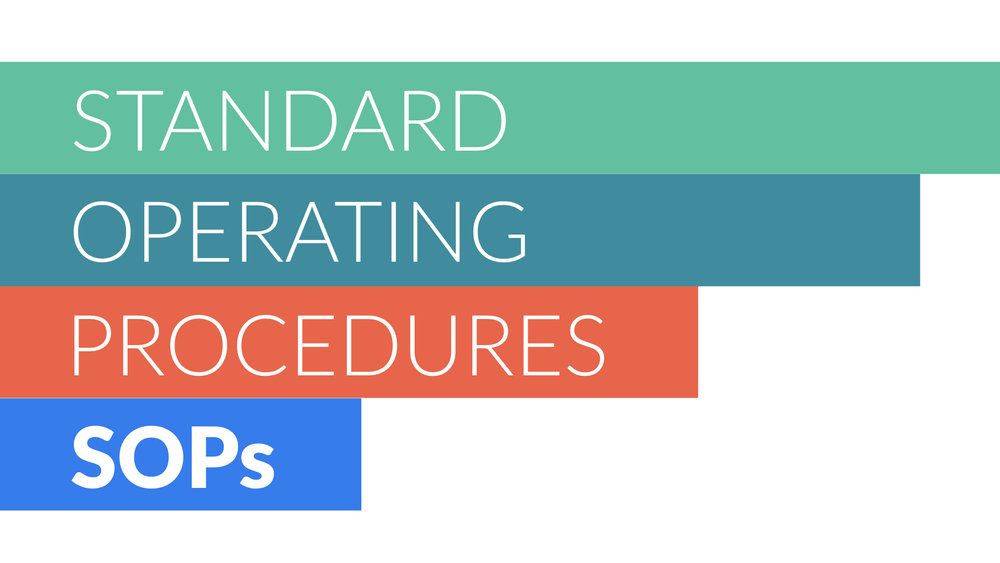
SOPs

Standard Operating Procedures:
SOPs are the secret sauce that makes everything taste better! It’s the magic wand that turns chaos into order and makes the action feel like a fun and exciting adventure. Imagine having a treasure map showing you exactly where the gold is buried – that’s what SOPs do for work tasks!
By using standard operating procedures, we can avoid the chaos and confusion that comes with not having clear instructions. It’s like having a helper bot help you get things done!
Standard operating procedures can be customized to fit any industry or task, making them the ultimate secret weapon for consistency, quality, and efficiency. And the best part? Makes work feel like a fun and exciting adventure! So let’s put on a superhero robe, grab our magic wands, and use standard operating procedures to overcome business difficulties!
Why are SOPs important?

There are several reasons why SOPs are important:
1. Consistency: SOPs ensure that tasks are performed consistently and according to established standards, regardless of who is performing them. This helps to ensure that the quality of work remains high and that errors are minimized.
2. Efficiency: SOPs provide a clear roadmap for completing tasks, which helps to streamline processes and reduce wasted time and effort. This can lead to improved productivity and cost savings.
3. Compliance: SOPs can help organizations comply with regulations and industry standards by ensuring that tasks are performed in a consistent and documented manner.
4. Training: SOPs provide a clear framework for training new employees and ensuring that they understand how to perform tasks correctly and safely.
5. Achieve consistent results. With standard operating procedures, you complete your processes in the same way and achieve the right results every time.
6. Reduce costs and increase productivity. When everyone does the same task in different ways, eventually your organization will run into inefficiencies that cost you time and money. With SOPs you can streamline the process and increase productivity.
7. Create a safe working environment. SOPs are very useful when it comes to safety. You provide a standardized way of getting things done with minimized risk of safety hazards. In this way your workers are safe and your company reduces the risk of liability.
Types of standard operating procedures
There are a few different types of SOPs, as different industries and organizations often follow various processes. Here are some examples of SOPs:
- Production: In production and manufacturing, an SOP may outline production line steps, equipment maintenance procedures, inspection processes and employee training programs. This type of SOP can ensure the regulation of a specific standard of production.
- Human resources: Within a variety of organizations, human resources professionals may draft SOPs to systematize employee training and development, disciplinary processes, performance reviews and the full scope of hiring procedures.
- Finance and administration: Finance and administration organizations may create SOPs to systemize their accounts receivable and accounts payable processes. This can ensure the maximization of cash flow, timely payment and streamlined billing processes.
- Legal: Legal professionals often work alongside business owners and organizational leaders to ensure their compliance with legal guidelines, such as privacy policies and accessibility regulations. An organization may create legal SOPs to ensure all employees understand the extent of these regulations and comply with them when completing their duties.
- Marketing, sales and customer support: In the field of marketing and customer support, organizations may create SOPs to regulate a wide variety of processes to ensure consumers have consistent experiences. These processes may include external communications approvals, preparation of sales quotes, service delivery processes, warranty, return and guarantee policies and customer support procedures.
How are SOPs developed?

Developing effective SOPs involves several key steps:
1. Identify the process or task to be documented: The first step is to identify the process or task that needs to be documented. This should be a process that is critical to the success of the organization or that involves a high degree of risk.
2. Gather information: The next step is to gather information about the process or task, including the inputs, outputs, and steps involved. This may involve observing the process, interviewing stakeholders, and reviewing relevant documentation.
3. Draft the SOP: Once the information has been gathered, the next step is to draft the SOP. This should include clear and concise instructions on how to perform the task or process, along with any necessary safety precautions, quality control measures, and documentation requirements.
4. Review and revise: The draft SOP should be reviewed by subject matter experts and other relevant stakeholders to ensure that it is accurate, complete, and easy to understand. It may be revised several times before the final version is approved.
5. Implement and monitor: Once the SOP has been approved, it should be implemented and monitored to ensure that it is being followed correctly and that it is achieving its intended goals.
Best practices for developing SOPs
Here are some best practices for developing effective SOPs:

1. Involve stakeholders: SOPs should be developed in collaboration with subject matter experts and other relevant stakeholders to ensure that they are accurate, complete, and relevant.
2. Keep it simple: SOPs should be written in clear and concise language that is easy to understand. Avoid technical jargon and use visual aids, such as diagrams or flowcharts, to help explain complex processes.
3. Be flexible: SOPs should be flexible enough to accommodate changes in the process or task over time. They should be reviewed and updated regularly to ensure that they remain relevant and effective.
4. Provide training: New employees should be trained on the SOPs relevant to their job responsibilities to ensure that they understand how to perform tasks correctly and safely.
5. Monitor and evaluate: SOPs should be monitored and evaluated regularly to ensure that they are achieving their intended goals and to identify areas for improvement.
There are several software tools and websites that can be used to implement (SOPs). Here are some examples:
1. Process Street: Process Street is a cloud-based platform that allows you to create and manage SOPs, checklists, and workflows for your business. It offers a user-friendly interface, customizable templates, and features such as conditional logic and automation.
2. Tallyfy: Tallyfy is a cloud-based platform that allows you to create and automate SOPs, workflows, and approvals. It offers features such as drag-and-drop process mapping, task assignments, and real-time analytics.
3. SweetProcess: SweetProcess is a cloud-based platform that allows you to create and share step-by-step procedures for your business. It offers a user-friendly interface, customizable templates, and features such as task assignments and notifications.
4. Microsoft SharePoint: Microsoft SharePoint is a web-based platform that allows you to create and manage SOPs, workflows, and other business processes. It offers features such as document management, version control, and collaboration tools.
5. Google Sites: Google Sites is a free web-based platform that allows you to create and share SOPs, checklists, and other business processes. It offers features such as customizable templates, real-time collaboration, and integration with other Google tools.
6. Evernote: Evernote is a note-taking and organizational tool that can be used to create and manage SOPs, checklists, and other business processes. It offers features such as customizable templates, task assignments, and integration with other tools.
These are just a few examples of the many software tools and websites that can be used to implement SOPs. When choosing a tool, it’s important to consider factors such as ease of use, customization options, collaboration features, and cost.
Conclusion
Standard Operating Procedures (SOPs) are a critical tool for ensuring consistency, quality, and safety in work processes across different industries and organizations. By providing clear and concise instructions on how to perform tasks, SOPs can streamline processes, reduce errors and risks, and increase efficiency. Developing effective SOPs requires collaboration with subject matter experts and other stakeholders, clear and concise language, and a commitment to monitoring




